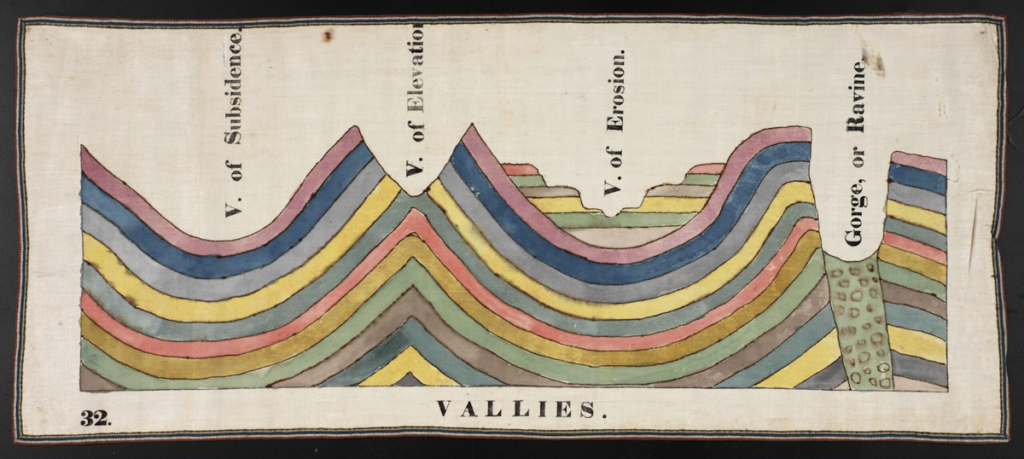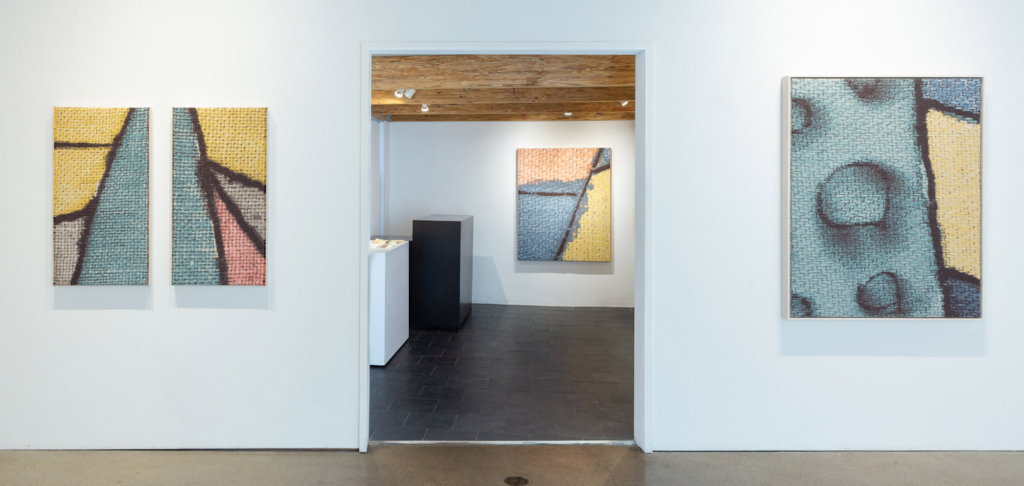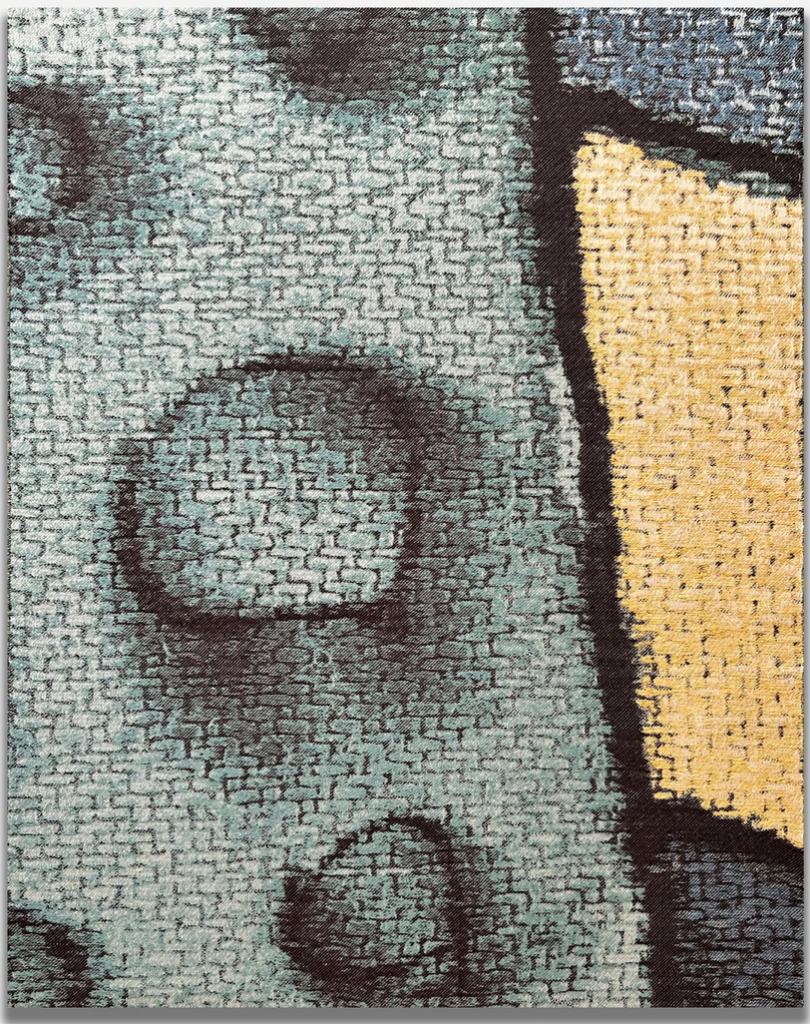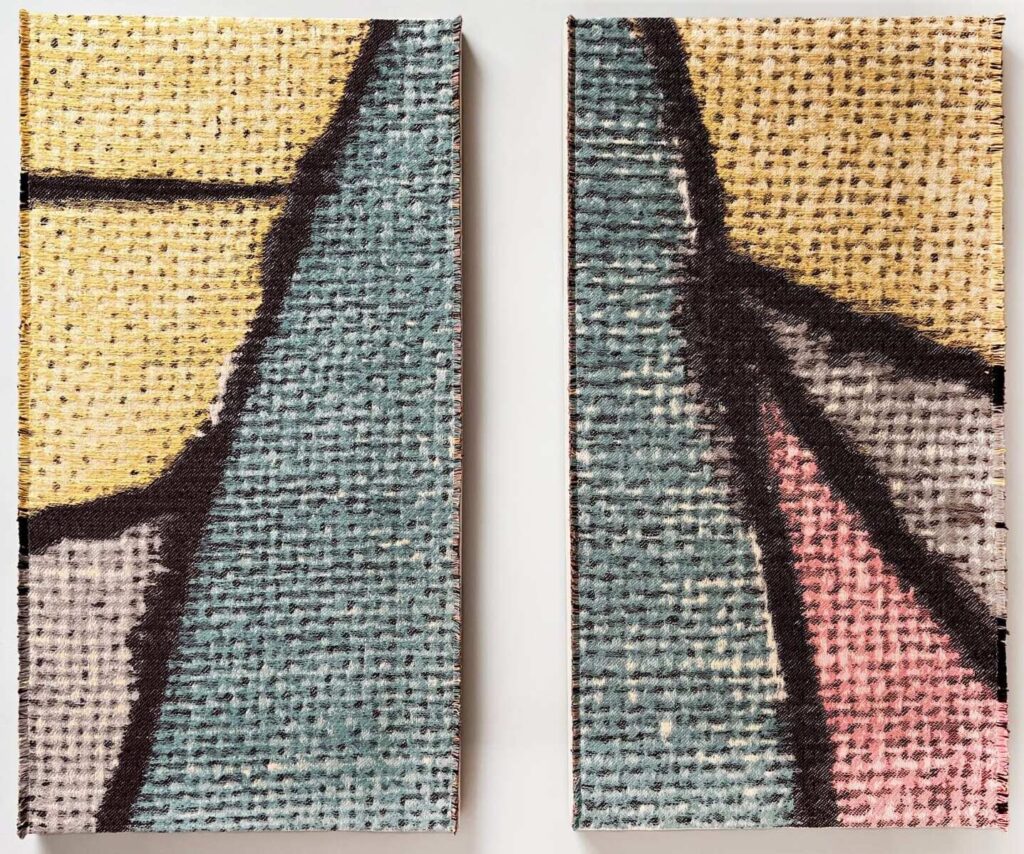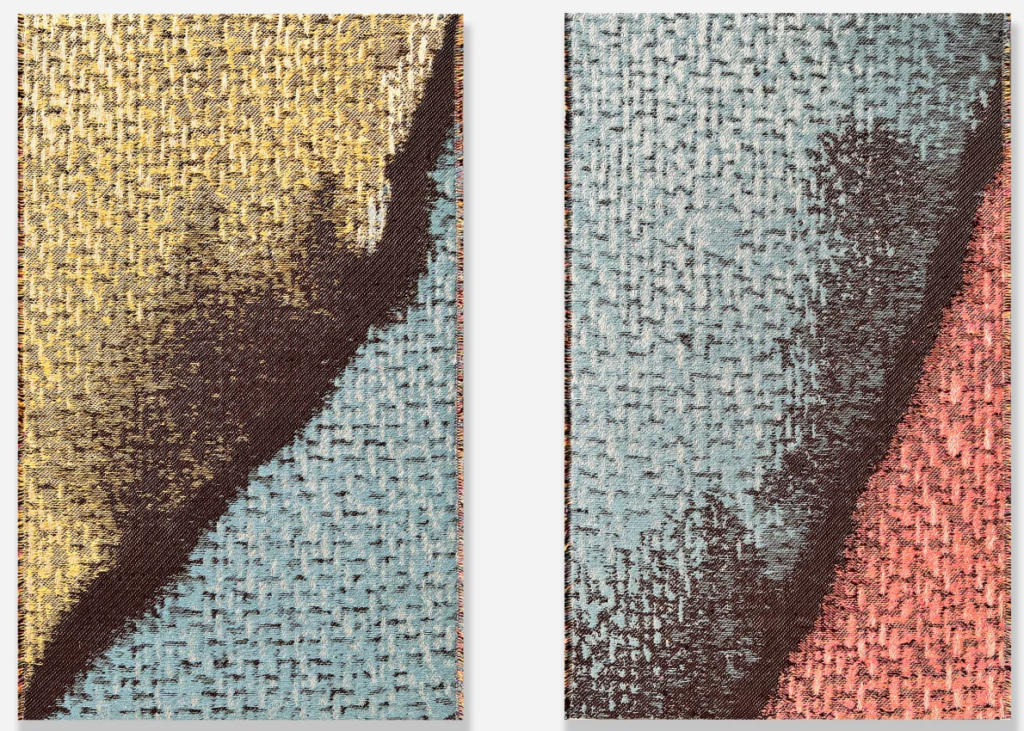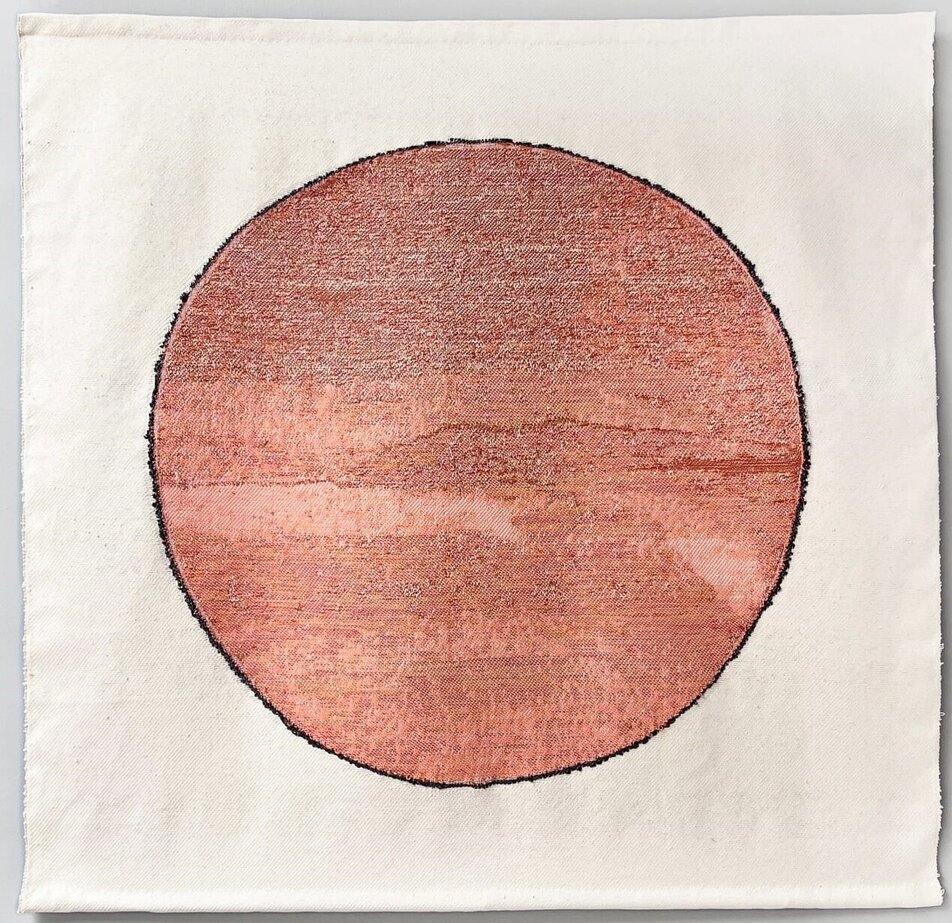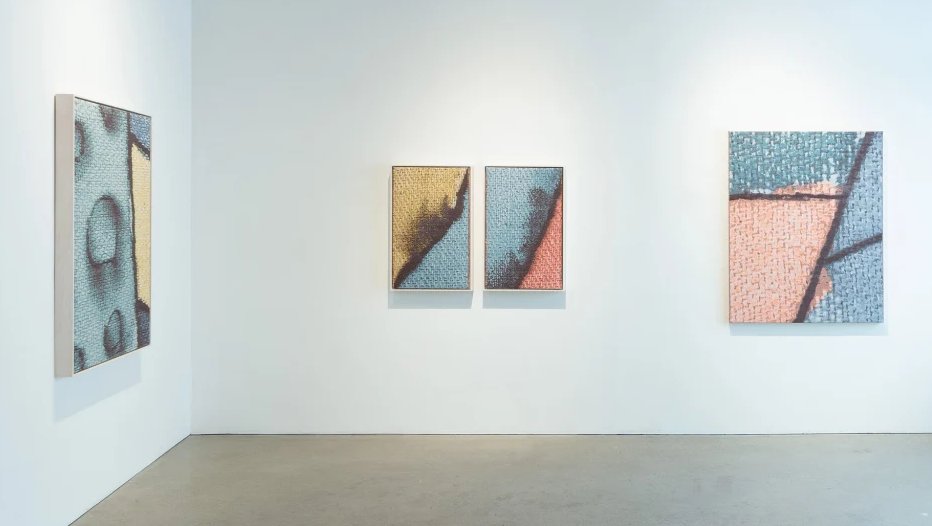In 2014 among the sweeping Scottish landscape, artist and weaver Meghan Price found herself interested in the layers of rocks which reminded her of Canada’s east coast. Despite being thousands of kilometres apart, and on different continents, Price paid attention to these geological similarities, which gave her the space to access the idea of time being evident through land and through, specifically, geology. The artist explained that “The strata of earth materials we understand often as a vertical timeline of the earth’s activities … weaving is very close to that as well: the cloth is built from the bottom up […] and it’s the actions of the body and incremental structuring of a line that is creating the object. So, the patterning in weaving can be associated with the patterning of the earth’s materials.” Thus, it would come as no surprise that when Orra White Hitchcock’s work revealed itself to her during the pandemic, Price was instantly interested; that interest grew into this exhibition, Through Line.
Orra White Hitchcock (March 8, 1796 – May 26, 1863) was a prolific illustrator, providing her husband – pastor and geologist Edward Hitchcock – with many scientific drawings for his classroom and research. A true Renaissance woman, Orra not only birthed eight children, ran the household, and taught decorative arts and watercolours, she also provided illustrations for her husband, cheered him up in his fits of melancholy, and filed his sermons. It has been quoted by their contemporaries that Edward Hitchcock “would not have been anything great, if [Orra Hitchcock] had not assisted him by her drawings of everything appertaining to his study of Geology” (Hitchcock, Orra White, and Robert L. Herbert. A Woman of Amherst: The Travel Diaries of Orra White Hitchcock, 1847 and 1850. iUniverse, Inc, 2008). Each image she made is rendered with an elegance befitting the Romantic Era, using a palette unique to the subject matter. Meghan Price’s exhibition at the United Contemporary provides viewers with an intimate look into Hitchcock’s bright and polychromatic designs.
Through Line is a macro-study of Hitchcock’s diagram of the stratigraphic makeup of valleys, each layer of earth painted in pastel colours: one layer is a cheerful yellow, the other a peachy pink. “I’ve never seen scientific diagrams made with watercolour on muslin, which is what [Hitchcock] was doing,” tells the artist during a phone interview. “I think what we’re used to in scientific representation is maybe just a very reduced palette, [or] one that is less soft, anyhow. And her material choice is kind of a soft thing as well and one that we would maybe associate more closely with domestic environments. [What’s] remarkable there is that she’s putting a line down, [and] the material interaction is going to cause that line to be kind of fuzzy: there’s that bleeding that’s happening. So as a person working in textiles, I’m very sensitive and interested in that world.”
Orra White Hitchcock’s work from Hollander, Stacey, Charting the Divine Path: The Art of Orra White Hitchcock 1796-1863 (New York: American Museum of Folk Art in collaboration with Amherst College Archives & Special Projects, 2018), exhibition catalogue.
Each of Price’s textiles are meticulously studied and then carefully planned – either on a draft or a computer – and programmed into her Jacquard Loom. This type of weaving is complicated and tricky; there are rigid parameters in which one must work. So, it was a “juicy technical challenge”, as she puts it, to translate the very fluid imagery of Orra White Hitchcock’s watercolour and ink diagrams into her own very structured methods of weaving.
Installation view of Meghan Price (L-R) Convergence, Strata 1., and Ravine, 2024, woven cotton. Courtesy of United Contemporary.
Price has expertly captured the texture and behaviour of Hitchcock’s muslin and watercolour diagram through very meticulous planning. Fascinated by the fabric’s qualities and mannerisms, and how that affects and interacts with the watercolour, Price provides a macro look into these interplays through her own woven artwork. Looking at “Ravine,” one would see ink seeping into the muslin, very slightly darkening the surrounding aqua, and then be stunned when reminded that this piece is not a wet medium but a textile. A closer look and one can even see the illusion of ink settling darkly into the wefts of the cotton cloth. When one considers how a loom can possibly achieve this, it becomes clear that everything about these reproductions is deliberate. That Price is able to not only capture the illusion of a wet medium through a weave but also include the features of that medium misbehaving is a striking display of dexterity.
Meghan Price, Ravine, 2024, handwoven cotton, stitched to canvas, 51.5 x 41 in. Courtesy of United Contemporary
“Convergence (Diptych)” provides the viewer with a closeup of where Hitchcock’s pen or brush meets multiple times, darkening the muslin further at each stroke and mixing with the watercolours. There are sections where the watercolours do not reach the ink lines, leaving a sliver of muslin exposed, and parts where the ink is caught between weft and warp. Clearly, these macro-takes focus on the idiosyncrasies of Hitchcock’s work, adding an intimacy to Price’s textiles. “When I’m following the stroke of [Orra’s] pen,” the artist said, “I’m thinking about her hand, but I’m also thinking about what was going on in the room where she was doing that work. I’m thinking about the demands that were placed on her that might have distracted her in a moment that would have caused her hand to create a very specific arc or to pause for a minute – whenever there’s a pause with that pen or that brush, we see more of the ink – so there’s some kind of clue there: a connection to her body and then a connection to the physical space that she was in.”
Meghan Price, Convergence, 2024, each woven cotton 38.5 x 20 in. Courtesy of United Contemporary
Looking at “Valleys Bleed (Diptych)” with Price’s imaginative lens, one might ask themselves what created such a smudge: was it Hitchcock’s finger? Did her sleeve catch the still-wet ink? What is a barely discernible error on a small scale offers, insights and stories become very visible on a large scale.
Meghan Price, Valleys Bleed (Diptych), 2024, each handwoven cotton, stitched to canvas, 32.5 x 20.5 in. Courtesy of United Contemporary.
Further in the vein of the Earth’s geological layers representing the passing of time, Price contemplates the age of humans and their relationship to the Earth: “The Crust of the Earth After Orra White Hitchcock” is a take on a separate illustration by Hitchcock, and it has woven in found material: a cassette tape. A ring of plastic encasing the Earth’s crust is a modern and topical take, one that was chosen while Price was thinking about “the Earth that we’re living on and how we are transforming it, how it has been transformed, and continues to be transformed by human activity.” It makes sense, aesthetically as well, to crunch the tape into the cloth, as “it takes on a real kind of crystalline quality which is kind of like coal or other geologic materials. So, I think it does a good job of expressing a crustiness of the earth[.]”
Meghan Price, The Crust of the Earth After Orra White Hitchcock, 2024, woven cloth and plastic waste, 40.5 x 40.25 in. Courtesy of United Contemporary.
Weft upon weft, each line of thread entwines to create a small detail in Orra Hitchcock’s work that would have gone unnoticed without Meghan Price’s hand. To focus on the minute errors is to connect on a very human level with both artists: from Hitchcock’s hand to muslin, from Price’s eye to loom, these particularities have made their way through time to connect us together now.
Installation view of Meghan Price, Through Line. Courtesy of United Contemporary.
Elin MacRae
*Exhibition information: Meghan Price, Through Line, May 23 – July 13, 2024, United Contemporary, 1444 Dupont Street, Unit 22, Toronto. Gallery hours: Wed – Sat, 11 am – 6 pm.
Special thanks to Meghan Price for her time, and to United Contemporary Gallery Director Melanie Trojkovic for the tour.

